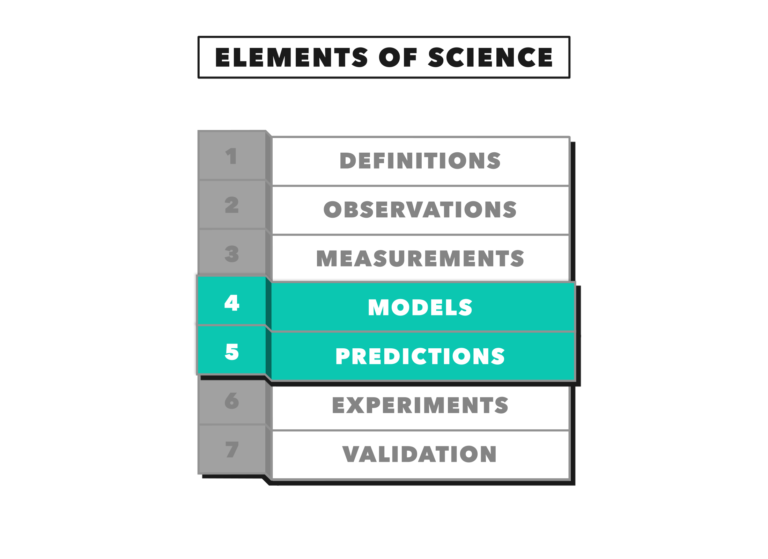Next to be considered in our review of the elements of science are models and predictions, the ultimate end of scientific models.

Scientific Models
A scientific model is an extraction of a direction or pattern from observed and measured phenomena: a real-world cause and effect relationship expressed in natural language, logic, or mathematics.
Scientists find patterns in observations: patterns of change and patterns of constancy. To the extent that any model works, it presumes cause and effect to predict the pattern will persist under some minimal set of criteria. Put another way, modeling is an attempt to fix causative conditions from which a particular effect — a predictable event — will ensue.
We can look back at our original discussion of modern science for three definitional claims regarding models (listed in the earlier post as points 4 – 6):
- Science creates models that account for observations of the real world. Science creates objective models that replace private, subjective models. These scientific models account for all relevant facts in their domain and predict new phenomena or relationships.
- Scientific models build on measurements of the observations. Measurements, the result of comparing observations with standards, provide consistency in observations and permit the sharing of experiences in an objective way. Measurements create facts; facts are measurements.
- Scientific models require validation through demonstrated predictions of qualitatively new phenomena or relationships. A qualitatively new phenomenon is one involving different parameters than those that formed the facts the scientist used to create the model.
We can also recall from our previous discussion that every model starts with definitions, made as precise as necessary and possible. From there, the model proceeds like mathematics, bound to follow the precepts of logic. The definitions are a direct link in the chain that connects the model to the real world.
Predictions
This chain connecting science to the real world operates according to two rules:
- Scientists create models from real data or by reasoning from real data.
- Models must admit validation through verification of their predictions of new data.
The objective of scientific modeling is to create generalizing and unifying descriptions that define and incorporate all relevant data and predict results for future experiments.
Put simply, science must do better than chance to a prescribed error level.
The claim of this series is not that the principle of prediction is sufficient in science. The claim is that in order for a science to be complete, prediction is necessary, not sufficient. Any science may be decomposed into a number of constituent parts, some of which would be missing prediction. Scientists can stake out a legitimate scientific career in a portion of their science, such as in making measurements and observations, developing taxonomies, developing and applying databases, or developing theorems. These are tangential or support roles, not primary scientific enterprises.
Prediction is thus proposed as the ultimate objective for science, replacing either simple explanation or description.
Grading Models
With this in mind, four recognizable categories form a natural, progressive system of ranking for models:
- Conjecture: an incomplete but consistent model or a model adapted from another domain and unsupported by relevant data.
- Hypothesis: a model (conjecture) based on existing data, making a non-trivial prediction but yet to receive any validation.
- Theory: a model (hypothesis) based on existing data with supporting confirmation, at least one validating datum, and no counter examples.
- Law: a model (theory) for which all explicit and implicit predictions have been validated to known levels of accuracy.
We will consider these model categories in greater detail in our upcoming discussion of experiments and validation.
For further reading on scientific models, consider Jeff Glassman’s earlier contributions previously published on CrossFit.com:
Additional Reading
Comments on Elements of Science: Models & Predictions
This is an incredible distillation of a very complex topic. I’ve read other works that said far less with many more words!
One thing missing here (possibly on purpose) is falsification. We often hear that a hypothesis or model is invalid unless it is falsifiable. This idea was first proposed by Karl Popper. Since then, it has become widely accepted.
Popper classified ideas binarily as either true or false. Whereas here, models are useful if they make better than chance predictions up to a known error rate. One thing that Popper and his followers (Kuhn, Lakatos, Feyerabend) believed is that no amount of tests or confirmatory evidence could ever prove a theory true. It would require an infinite number of experiments to do so. By extension, any piece of confirmatory evidence does not even strengthen the validity of a theory.
How could a working scientist ever possibly make progress under such conditions?
If you want to read a more eloquent and comprehensive critique of Popper, CrossFit Health has linked to a book by David Stove that goes into great detail on this topic. www.crossfithealth.com/2018/04/06/popper-and-after-by-david-stove/
Elements of Science: Models & Predictions
1